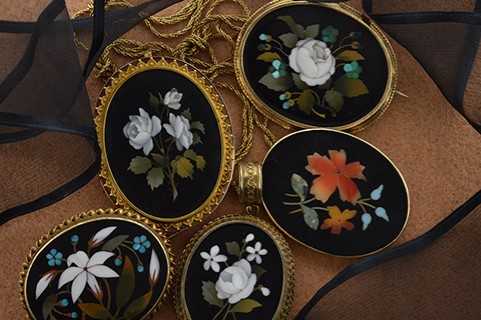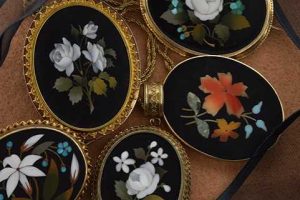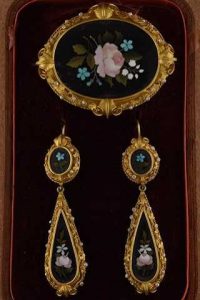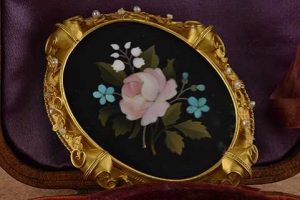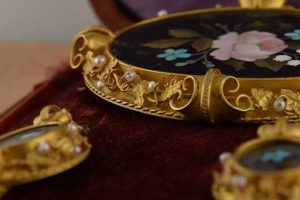Joden Girl
Baubles, Bling and Inlaid Things
By definition, inlaid means “ornamented with embedded pieces of a decorative material flush with the surface”. This process dates back to the 1600’s and has been practiced for hundreds of years. The art originated in Florence, Italy. The craft itself was utilized to decorate architectural structures like doors and windows as well as ornamental pieces like furniture, fountains and sculptures.
Inlaid jewelry experienced a revival in the 19th century. The style became known as Pietra Dura (which means hard stone in Italian). Taking cues from Commesso mosaic work, Pietra Dura focused on fashioning pictures from carefully sawn pieces of semi-precious gemstones and fitting them together like a jigsaw puzzle. Typically floral in nature, they were usually constructed on a green, white or black base. Not to be confused with micro-mosaic, Pietra Dura is a refined process that employs larger hand-cut bits of beautifully colored stones like agate, jasper, lapis, jade, malachite, onyx, quartz and alabaster.

This brooch from the late 1800’s features an oval piece of black slate encapsulated by a simple 14-karat yellow gold frame. Showcasing a pair of orange five-petaled blossoms with a sprig of blue buds, this botanical brooch measures approximately 1.75 inches by 1.5 inches.


Shown from behind, you can see a small round ring that is hinged at the base. This tiny loop allows the brooch to be worn on a chain as a pendant. It is thoughtfully hidden away when the piece is used as a pin. Available in our store, this lovely piece of inlaid jewelry is priced at just $585.00.
In the mid-twentieth century, two men formed a partnership and created what is now considered to be the finest inlaid modern gold jewelry. Their names were Jerome Grossbardt and Larry Asch. Together, they became Asch-Grossbardt.


Recognized for exquisite color combinations and whimsical designs, the Asch-Grossbardt legacy is filled with miniature masterpieces. That turtle pictured above is one of my favorites. He’s just a little fellow, measuring 1.25 inches from the top of his head to the tip of his tail. His wide set eyes are marked by a matched pair of round coral beads. His shell is where the magic happens… nine individual scales have been hand-cut from a combination of lapis, malachite, onyx, mother-of-pearl and coral. These meticulously cut gems are set and then the finished product is lapped on a wheel until the surface is silky smooth.
Every Asch-Grossbardt design is original and copyrighted, a fact which makes them highly collectible. Our adorable turtle is priced at just $480!

Pictured together, both pieces are made from 14-karat yellow gold. Both of them also features an inlaid pattern showcasing a similar color palette of hand-cut semi-precious gemstones. We can’t help but wonder… which would you choose? This antique Pietra Dura flower brooch or that Asch-Grossbardt turtle? This or that?
“You can go to a museum and look, or come to us and touch.”
Written by Carrie Martin
Photos by Dana Jerpe


